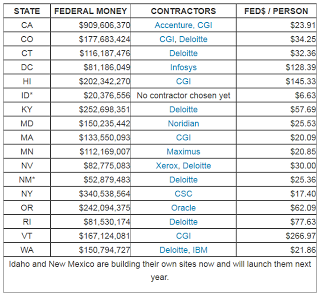Kentucky’s health-insurance exchange has covered a greater share of population than any other state-based exchange

“Our system doesn’t have a lot of bells and whistles,” Carrie
Banahan, executive director of the Kentucky Health Benefits Exchange (the formal name of Kynect), told Vestal. “There aren’t a lot of graphics that would take a lot of bandwidth.”
“Kentucky and other top-performing states enable consumers to browse
the various plans available on the exchange without first having to set
up a password-protected account,” Vestal notes. “That step alone spared those exchanges a
lot of error messages and screen freezes experienced by people using
the federal site,” Healthcare.gov.
“Successful states also devoted months, not weeks, to exhaustive,
round-the-clock testing,” Vestal writes. “Kentucky tested for three months, while the
U.S. Department of Health and Human Services reportedly devoted only the
last two weeks of September to testing Healthcare.gov before its Oct. 1
launch.”
The four most successful states – Connecticut, Kentucky, Rhode Island and Washington – all contracted with the consulting firm Deloitte “to manage and develop their sites,” using federal funds, Vestal reports. Kentucky’s expenses for its exchange were higher than average. (Stateline chart)
UPDATE: As of 7 p.m. Thursday, Dec. 5, after 10 days of increased traffic and enrollments, the exchange said it had enrolled 71,955 people, 56,437 of them in Medicaid and 15,518 in private plans. Most of the 28,307 who had been found eligible for a subsidy to buy a private plan had not chosen a plan yet. Dental plans had 5,074 enrollees.
